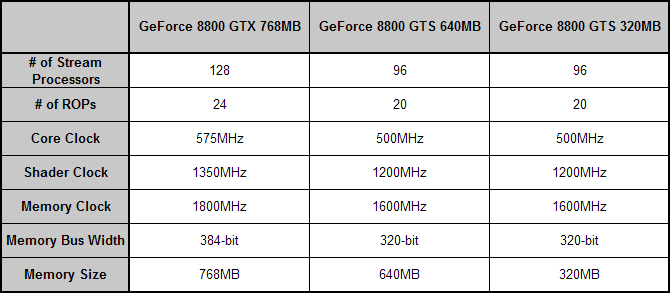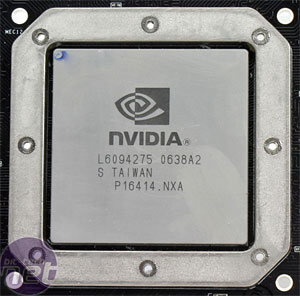GeForce 8800 series round-up
February 20, 2007 | 15:51

During our extensive coverage of Nvidia’s GeForce 8800-series graphics cards, we have seen the company’s partners follow the GeForce 8800 GTS and GTX reference designs almost right down to the letter. Initially, Nvidia went to the extent of preventing its partners from overclocking its G80 graphics chips right from launch because of the GeForce 7-series overclocking fiascos that caused quite a bit of unrest in the community.
With no overclocking allowed, the only ways that partners could really differentiate themselves from one another was customising box / card artwork and bundles, while trying to remain competitive on price with everyone else. That meant there was a pretty boring market and very little opportunity for partners to really offer something unique.
However, just in time for Christmas, Nvidia removed the factory overclocking curfew placed on its partners and XFX was the first to announce pre-overclocked GeForce 8800-series cards. It was Foxconn that managed to get us a pre-overclocked card first though, with its FV-N88SMBD2-ONOC GeForce 8800 GTS that shipped with its clock speeds set at the reference GeForce 8800 GTX frequencies. Obviously though, the cut-down shader architecture used on GeForce 8800 GTS meant that Foxconn’s card wasn’t as fast as a run-of-the-mill GeForce 8800 GTX.

GeForce 8800 series in a nutshellBoth GeForce 8800 GTX and GeForce 8800 GTS 640MB were released on November 8th last year, while the third addition to Nvidia’s 8800 series – GeForce 8800 GTS 320MB – was released by the company just last week.
 GeForce 8800 GTX is currently Nvidia’s flagship product and features 128 stream processors, 32 texture address units, 64 texture filtering units, 24 ROPs and a 384-bit memory bus width. At the moment, it’s best suited to gamers looking to attain decent gameplay at either 2560x1600 or 1920x1200. Although, if you’re looking to game at 2560x1600, you’re going to be right on the edge with a single 8800 GTX – you’ll get a much better experience with a pair of GTXs in SLI. Of course, that’s only true on Windows XP at the moment though, because the company admits that its Vista drivers currently aren’t up to scratch.
GeForce 8800 GTX is currently Nvidia’s flagship product and features 128 stream processors, 32 texture address units, 64 texture filtering units, 24 ROPs and a 384-bit memory bus width. At the moment, it’s best suited to gamers looking to attain decent gameplay at either 2560x1600 or 1920x1200. Although, if you’re looking to game at 2560x1600, you’re going to be right on the edge with a single 8800 GTX – you’ll get a much better experience with a pair of GTXs in SLI. Of course, that’s only true on Windows XP at the moment though, because the company admits that its Vista drivers currently aren’t up to scratch.
The 640MB GeForce 8800 GTS is a much more affordable than GeForce 8800 GTX, and the result of the cost-cutting was a GPU that has around 66 percent of the raw shader horsepower in the GTX. The number of stream processors has been reduced by 25 percent – down from 128 to 96 – and the GPU’s texture capabilities were also culled by the same ratio. The final cuts were made to the ROPs (down from 24 to 20) and as a direct result of that, the memory bus width was reduced from 384-bits to 320-bits. This particular product performs at its best when running at resolutions of 1920x1200, 1680x1050 and 1600x1200.
The latest addition to the GeForce 8800 family is the 8800 GTS 320MB, which we covered in some detail last week when it launched. The card is exactly what it says on the tin – it has all of the architectural characteristics of the original 8800 GTS, but with half the memory footprint. As a result of the memory size reduction, the 8800 GTS 320MB comes in at a very affordable price and creeps into the performance mainstream sector that fits in between the high-end and mid-range price segments.
By Nvidia’s own admission, GeForce 8800 GTS 320MB is designed to deliver great gaming experiences at ‘mainstream’ resolutions – i.e. 1600x1200, 1680x1050 and 1280x1024 (to some degree). As we found in our initial 8800 GTS 320MB coverage and performance investigations, gaming at 1920x1200 is possible, but using higher levels of anti-aliasing is almost like walking across nuclear wasteland in anything remotely graphically intense – you just wouldn’t do it because the frame rates get incredibly low, very quickly.
With no overclocking allowed, the only ways that partners could really differentiate themselves from one another was customising box / card artwork and bundles, while trying to remain competitive on price with everyone else. That meant there was a pretty boring market and very little opportunity for partners to really offer something unique.
However, just in time for Christmas, Nvidia removed the factory overclocking curfew placed on its partners and XFX was the first to announce pre-overclocked GeForce 8800-series cards. It was Foxconn that managed to get us a pre-overclocked card first though, with its FV-N88SMBD2-ONOC GeForce 8800 GTS that shipped with its clock speeds set at the reference GeForce 8800 GTX frequencies. Obviously though, the cut-down shader architecture used on GeForce 8800 GTS meant that Foxconn’s card wasn’t as fast as a run-of-the-mill GeForce 8800 GTX.
GeForce 8800-series:
Today, we have a selection of cards from BFGTech, EVGA, Leadtek and XFX that cover the three different price brackets the GeForce 8800 series currently operates in: GeForce 8800 GTS 320MB, GeForce 8800 GTS 640MB and GeForce 8800 GTX 768MB. Before we get down and dirty with the cards, it’s worth giving you a quick run down of where each of the three products fits into the grand scheme of things.
GeForce 8800 series in a nutshell
 GeForce 8800 GTX is currently Nvidia’s flagship product and features 128 stream processors, 32 texture address units, 64 texture filtering units, 24 ROPs and a 384-bit memory bus width. At the moment, it’s best suited to gamers looking to attain decent gameplay at either 2560x1600 or 1920x1200. Although, if you’re looking to game at 2560x1600, you’re going to be right on the edge with a single 8800 GTX – you’ll get a much better experience with a pair of GTXs in SLI. Of course, that’s only true on Windows XP at the moment though, because the company admits that its Vista drivers currently aren’t up to scratch.
GeForce 8800 GTX is currently Nvidia’s flagship product and features 128 stream processors, 32 texture address units, 64 texture filtering units, 24 ROPs and a 384-bit memory bus width. At the moment, it’s best suited to gamers looking to attain decent gameplay at either 2560x1600 or 1920x1200. Although, if you’re looking to game at 2560x1600, you’re going to be right on the edge with a single 8800 GTX – you’ll get a much better experience with a pair of GTXs in SLI. Of course, that’s only true on Windows XP at the moment though, because the company admits that its Vista drivers currently aren’t up to scratch.The 640MB GeForce 8800 GTS is a much more affordable than GeForce 8800 GTX, and the result of the cost-cutting was a GPU that has around 66 percent of the raw shader horsepower in the GTX. The number of stream processors has been reduced by 25 percent – down from 128 to 96 – and the GPU’s texture capabilities were also culled by the same ratio. The final cuts were made to the ROPs (down from 24 to 20) and as a direct result of that, the memory bus width was reduced from 384-bits to 320-bits. This particular product performs at its best when running at resolutions of 1920x1200, 1680x1050 and 1600x1200.
The latest addition to the GeForce 8800 family is the 8800 GTS 320MB, which we covered in some detail last week when it launched. The card is exactly what it says on the tin – it has all of the architectural characteristics of the original 8800 GTS, but with half the memory footprint. As a result of the memory size reduction, the 8800 GTS 320MB comes in at a very affordable price and creeps into the performance mainstream sector that fits in between the high-end and mid-range price segments.
By Nvidia’s own admission, GeForce 8800 GTS 320MB is designed to deliver great gaming experiences at ‘mainstream’ resolutions – i.e. 1600x1200, 1680x1050 and 1280x1024 (to some degree). As we found in our initial 8800 GTS 320MB coverage and performance investigations, gaming at 1920x1200 is possible, but using higher levels of anti-aliasing is almost like walking across nuclear wasteland in anything remotely graphically intense – you just wouldn’t do it because the frame rates get incredibly low, very quickly.

MSI MPG Velox 100R Chassis Review
October 14 2021 | 15:04








Want to comment? Please log in.